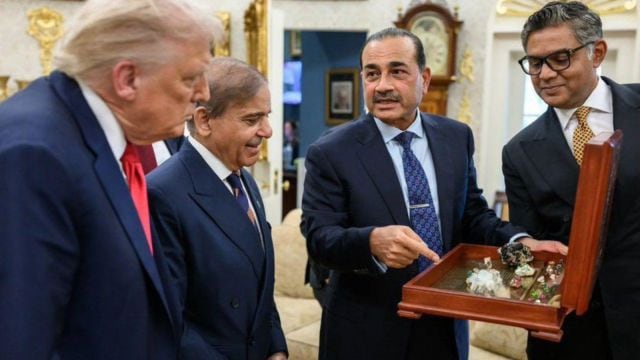
The widely circulating images of US President Donald Trump’s recent meeting with Pakistan Prime Minister Shehbaz Sharif and army chief Asim Munir evoke the Punjabi expression “Rabb khair kare (May God keep everything well)”. The US and Pakistan have never had strategic congruence, but have periodically come together in a transactional relationship with disastrous consequences. Their Cold War partnership and the resulting large US financial and arms flows to the Pakistan army contributed to its turning into a praetorian force, encouraging it to pursue deleterious policies within and outside Pakistan. Their association during the “Afghan jihad” unleashed the most retrograde religious zealots, who have continued to haunt the region and the global community for over three decades and have finally come home to roost. Pakistan joined the US War on Terror under duress, but played a Janus-faced role in bringing the Taliban, which had been ousted at the beginning of the campaign, back to power in Kabul. In a classic case of fatal attraction, the US has come back to partner with the Pakistan army.
The aforementioned meeting comes in the backdrop of the Pakistan-US bonhomie in recent months, which signals a new transactional phase. In June, Trump hosted Munir at a luncheon meeting in the White House. The consequences of this transactional phase may not be known for quite some time. But let us look at what lies behind it.
It appears to have originated with the Trump family’s reported interest in the crypto business in Pakistan, thereby providing the Pakistanis a valuable connection to the White House. They then dangled the critical minerals carrot, resulting in a US company signing a $500 million investment deal with Pakistan earlier this month.
Islamabad and Rawalpindi were quick to endorse Trump’s repeated claims of having “stopped a war” between India and Pakistan in May, and nominated him for the Nobel Peace Prize.
Not much is known about the content of the meeting. Sketchy information released by the Prime Minister’s Office speaks of Sharif inviting US investment in the agriculture, information technology, mining and energy sectors, and discussing counterterrorism cooperation. But the economic content of the meeting seems overblown. Aside from crypto business and critical minerals, Pakistan cut a trade deal with the US at a relatively low tariff rate of 19 per cent. However, the overall bilateral trade is low, at a little over $7 billion per annum. Trump has spoken of the US role in developing Pakistan’s “massive oil reserves”. But Pakistan does not have any proven “massive” energy reserves, and extensive exploration would be an uphill task in view of Pakistan’s current security environment.
The manner in which Munir has been feted by Trump seems to suggest a substantive security content in the discussions. It could not be just about counterterrorism. Are the Americans trying to enlist Pakistan’s support in the context of Iran or Afghanistan? The Taliban is resisting the US demand for the Bagram airbase. Pakistan also seems to be nearing a breaking point with the Taliban, inter alia, on the issue of alleged terror attacks from Afghan soil. Could the two sides join hands to exert pressure on the Taliban?
Further, Pakistan signed a Strategic Mutual Defence Agreement with Saudi Arabia recently, with barely concealed references by the two sides to a possible Pakistani nuclear umbrella for Saudi Arabia. However, this sensitive aspect does not seem to have stirred any non-proliferation souls in Washington, DC enough to warrant a public statement. Could it be that the Americans were kept in the loop and see a role for Pakistan in the security architecture of West Asia under their tutelage? The Americans may also want Pakistan to be part of the International Stabilisation Force envisaged in the 21-point plan on Gaza presented by Trump to Arab and Muslim countries in New York on September 24. Incidentally, Sharif has lauded Trump’s efforts to bring an immediate end to the war in Gaza. These are all possible scenarios. Things should become clearer in the coming months.
The road to the latest transactional phase will not be smooth. We will have to see how Pakistan balances its cosying up to the Trump administration with its relationship with China, which has widened and deepened significantly. Moreover, in taking up any security role in West Asia, the Pakistanis risk getting caught in the quagmire of the region and may be biting off more than they can chew because of their own fraught security environment.
The upswing in the US-Pakistan relationship comes at a time when there are serious irritants in the US-India relationship. The Pakistan-US partnership has impacted us adversely in the past. Resumption of financial aid and military supplies by the US to Pakistan would be a matter of concern to India, as would enhanced financial flows from the Saudis or investment by them in Pakistan’s military-industrial complex. West Asia is India’s extended neighbourhood and of vital interest to it. Any role for Pakistan in its security architecture would equally be of concern.
Further, Pakistan is slowly emerging from the geopolitical tight spot in which it had found itself for over two decades because of its serious internal problems and terrorists with links to it surfacing all over the world. It enjoys solid support from China, as evident during Operation Sindoor. The recent defence agreement with Saudi Arabia and the improving relationship with the US add to this trend. Experience tells us that when Pakistan has a stable equation with its key international partners, it feels emboldened to be more adventurous towards India. We will have to keep a close eye on further developments to safeguard our interests.
Sabharwal is a former high commissioner to Pakistan and author of India’s Pakistan Conundrum: Managing a Complex Relationship